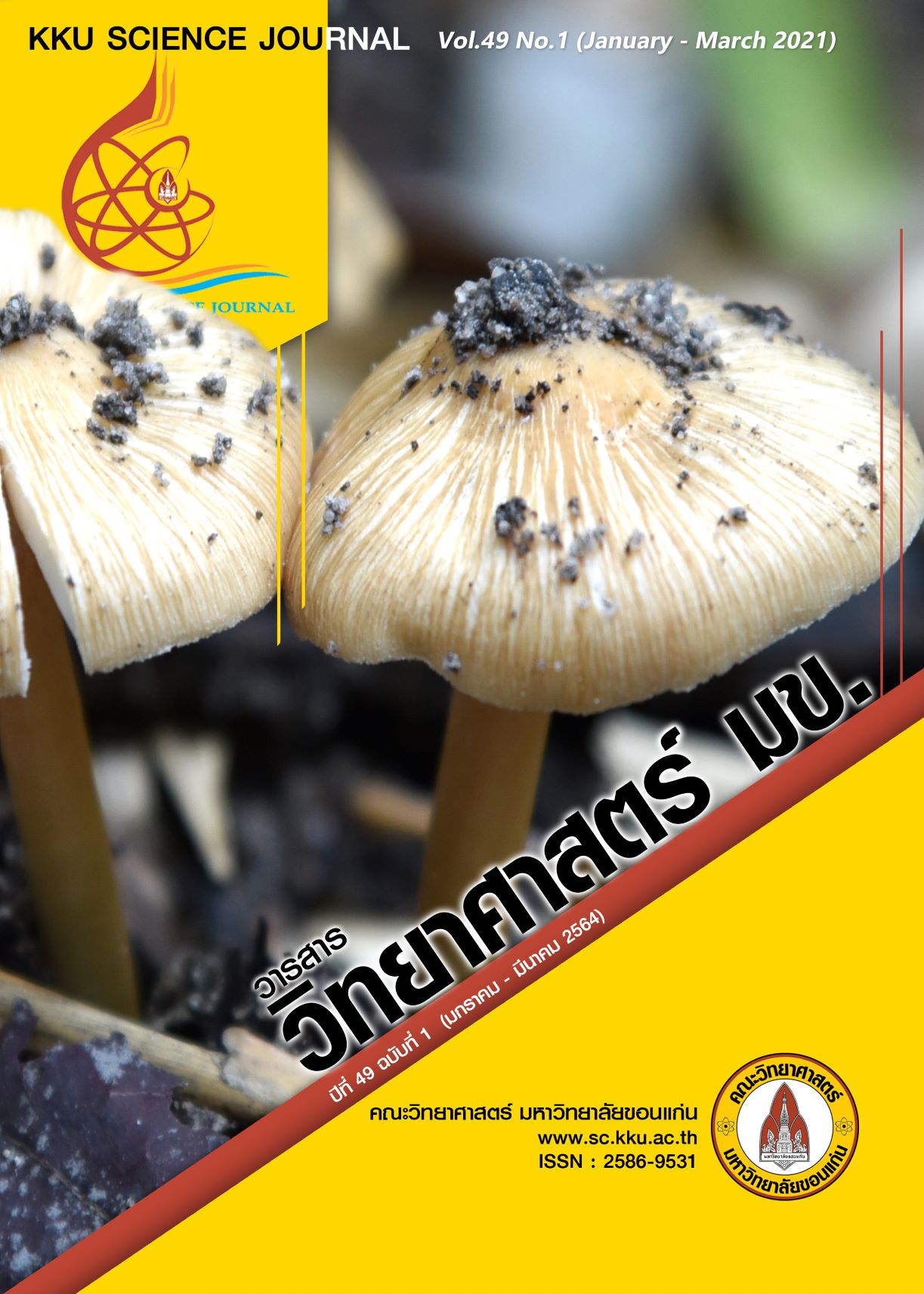ผลของไดโอดเปล่งแสงต่อความงอกของเมล็ด และการสะสมปริมาณฟีนอลิกในต้นอ่อนพืช
Main Article Content
บทคัดย่อ
ไดโอดเปล่งแสง (LED) เป็นแหล่งให้แสงที่ประหยัดพลังงาน และเป็นเทคโนโลยีการให้แสงที่มีศักยภาพที่สามารถนำมาปรับใช้สำหรับการผลิตพืช แสงจาก LED มีผลทั้งกระตุ้นความงอกของเมล็ดพืช และการสังเคราะห์สารออกฤทธิ์ทางชีวภาพ ซึ่งช่วยเพิ่มคุณค่าทางโภชนาการและสารต้านอนุมูลอิสระในต้นอ่อนพืช การศึกษานี้มีวัตถุประสงค์เพื่อทดสอบผลของ LED ต่อความงอกของเมล็ด และการสะสมสารต้านอนุมูลอิสระในต้นอ่อนพืช โดยใช้แสงผสมระหว่างสีแดง (630 nm) และสีน้ำเงิน (470 nm) ที่ความเข้มแสงต่างกันซึ่งได้ทำการเพาะเมล็ดข้าว ถั่วเขียว ทานตะวัน และงา ภายใต้ LED แสงสีแดงร่วมกับสีน้ำเงินอัตราส่วน 7:3 ที่ความเข้มแสง 3 ระดับ (400, 200 และ 145 μmol/m2/s) เปรียบเทียบกับการไม่ให้แสง ผลการทดลองพบว่าการใช้ LED สีแดงร่วมกับสีน้ำเงินที่ความเข้มแสง 145 μmol/m2/s แก่เมล็ดพืช ส่งผลให้มีกิจกรรมของเอนไซม์แอลฟาอะไมเลสในเมล็ด และปริมาณฟีนอลิกในต้นอ่อนข้าวสูงที่สุด และยังพบว่าความเข้มแสง 200 และ 145 μmol/m2/s ส่งผลให้เมล็ดพืชทุกชนิดมีเปอร์เซ็นต์ความงอกสูง ดังนั้นการให้แสง LED สีแดงร่วมกับสีน้ำเงินที่ความเข้มแสง 145–200 μmol/m2/s สามารถเพิ่มกิจกรรมเอนไซม์แอลฟาอะไมเลส และความงอกของเมล็ดพืชรวมถึงเพิ่มปริมาณฟีนอลิกในต้นอ่อนพืชได้
Article Details

This work is licensed under a Creative Commons Attribution-NonCommercial-NoDerivatives 4.0 International License.
References
Ajdanian, L., Babaei, M. and Aroiee, H. (2019). The growth and development of cress (Lepidium sativum)affected by blue and red light. Heliyon 5(7): 1–9.
Akbarian, B., Matloobi, M. and Mahna, N. (2016). Effects of LED Light on Seed Emergence and Seedling Quality of Four Bedding Flowers. Journal of Ornamental Plants 6(2): 115–123.
Bewley, J. D., Bradford, K., Hilhorst, H. and Nonogaki, H. (2013). Seeds: Physiology of development, germination and dormancy. 3rd Edition. New York: Springer-Verlag.
Boonyakiat, D. (2011). Plant Physiology [On-line], Available: www.cssckmutt.in.th/cssc/cssc_classroom/...Doc/10_Plant%20and%20Solar.pdf.
Butsabasri, T. (2012). World Population [On-line], Available: https://www.gotoknow.org/posts/418083
Darko, E., Heydarizadeh, P., Schoefs, B., and Sabzalian, M. R. (2014). Photosynthesis under artificial light: the shift in primary and secondary metabolism. Philosophical Transactions of the Royal Society B: Biological Sciences. 369(1640): 1–7.
Johkan, M., Shoji, K., Goto, F., Hashida, S. and Yoshihara, T. (2010). Blue Light-emitting Diode Light Irradiation of Seedlings Improves Seedling Quality and Growth after Transplanting in Red Leaf Lettuce. HortScience 45(12): 1809–1814.
Kato-Noguchi, H. and Macías, F. A. (2005). Effects of 6-methoxy-2-benzoxazolinone on the germination and α-amylase activity in lettuce seeds. Journal of Plant Physiology 162(12): 1304-1307.
Lal, N. and Sachan, P. (2017). Effect of different Visible Light wavelengths on Seed Germination and Photosynthetic Pigment Contents in Vigna unguiculata (L.) Walp. Indian Jounal of Biology 4(2): 132–136.
Lobiuc, A., Vasilache, V., Pintilie, O., Stoleru, T., Burducea, M., Oroian, M. and Zamfirache, M. M. (2017). Blue and Red LED Illumination Improves Growth and Bioactive Compounds Contents in Acyanic and Cyanic Ocimum basilicum L. Microgreens.Molecules 22(2111): 1-14.
Nie, N. H., Hull, C. H. and Bent, D. H. (1970). SPSS: Statistical package for the social sciences. United stated: McGraw-Hill.
Ohashi-Kaneko, K., Matsuda, R., Goto, E., Fujiwara, K. and Kurata, K. (2006). Growth of rice plants under red light with or without supplemental blue light.Soil Science and Plant Nutrition. 52(4): 444–452.
Patel, E. K., Chandawat D. K. and Patel, Y. M. (2017). Effect of light on seed germination of Vigna radiata. European Journal of Pharmaceutical and Medical Research 4(12): 444–448.
Ryu, J. H., Seo, K. S., Choi, G. L., Rha, E. S., Lee, S. C., Choi, S. K., Kang, S. Y. and Bae, C. H. (2012). Effects of LED Light Illumination on Germination, Growth and Anthocyanin Content of Dandelion (Taraxacum officinale). Korean Journal of Plant Resources 25(6): 731–738.
Samuolienė, G., Urbonavičiūtė, A., Brazaitytė, A., Šabajevienė, G., Sakalauskaitė, J. and Duchovskis, P. (2011). The impact of LED illumination on antioxidant properties of sprouted seeds. Central European Journal of Biology. 6(1): 68–74.
Taiz, L. and Zeiger, E. (2010). Plant Physiology. 5th Edition. Sunderland, Massachusetts U.S.A.: Sinauer Associates Inc.
Vaštakaitė, V., Viršilė, A., Brazaitytė, A., Samuolienė, G., Jankauskienė, J., Sirtautas, R., Novičkovas, A., Dabašinskas, L., Sakalauskienė, S., Miliauskienė, J. and Duchovskis, P. (2015). The Effect of Blue Light Dosage on Growth and Antioxidant Properties of Microgreens. Scientific works of the institute of horticulture, lithuanian research centre for agriculture and forestry and aleksandras stulginskis university. Sodininkystė ir daržininkystė 34(1–2): 25-35.
Zhao, M., Zhang, H., Yan, H., Qiu, L. and Baskin, C. C. (2018). Mobilization and Role of Starch, Protein, and Fat Reserves during Seed Germination of Six Wild Grassland Species. Frontiers in Plant Science. 9(234): 1-11.

